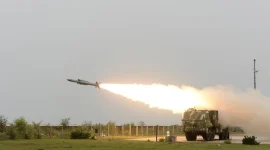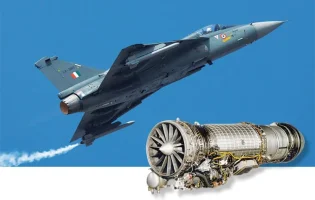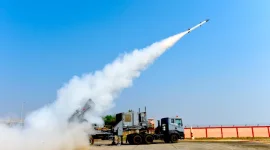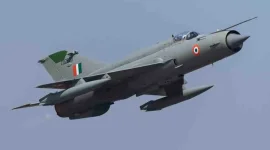- Views: 3K
- Replies: 8
Following the successful induction of its first Akash-1S air defence missile systems, Armenia is reportedly looking to acquire the more advanced Akash-Next Generation (NG) system from India.
This move aims to significantly boost its capability to counter threats from aircraft, missiles, and drones with greater precision.
Armenia is strengthening its defence cooperation with India and is scheduled to receive the second consignment of the Akash-1S air defence missile system after July 2025. The initial battery was successfully delivered in November 2024. This procurement is part of a substantial $720 million agreement made in 2022 for a total of 15 Akash systems.
The acquisition represents a key component of Armenia's strategy to modernise its air defence infrastructure amidst ongoing regional security concerns. Sources indicate that the South Caucasian nation is already expressing significant interest in the Akash-NG, which is anticipated to begin production in 2026.
The Akash-1S, an upgraded version of the original Akash missile developed by India’s Defence Research and Development Organisation (DRDO), has already demonstrated its capabilities for Armenia.
Featuring an indigenously developed seeker, the Akash-1S offers an improved probability of successfully destroying targets. It can accurately engage aerial threats including fighter jets, cruise missiles, and unmanned aerial vehicles (UAVs) at distances up to 30 kilometres.
Each system, produced by Indian public sector undertakings Bharat Dynamics Limited (BDL) and Bharat Electronics Limited (BEL), comprises four launchers, each armed with three missiles, along with the advanced Rajendra 3D radar, ensuring a robust defence shield.
This acquisition highlights Armenia's strategic decision to diversify its sources of military hardware, thereby lessening its previous heavy reliance on Russia, which supplied over 90% of its arms imports between 2011 and 2020.
Reports suggest that the first Akash-1S battery delivered to Armenia has performed effectively during initial assessments, with its advanced seeker technology enabling proficient target detection and interception.
This positive performance has reinforced Armenia's trust in Indian defence manufacturing, leading to discussions regarding the Akash-NG. This next-generation system is designed to counter more sophisticated and evolving aerial threats.
The Akash-NG features a considerably longer engagement range of 70 to 80 kilometres, a lighter dual-pulse solid rocket motor for enhanced kinematics, and an Active Electronically Scanned Array (AESA) multi-function radar. AESA radars allow for quicker tracking of multiple targets and offer improved resistance to electronic countermeasures.
While the Akash-NG is currently awaiting final orders from the Indian Army and Air Force, its production is projected to start in 2026, though this timeline could see adjustments based on ongoing user trials.
Armenian defence officials have reportedly been briefed on the capabilities of the Akash-NG, and the nation has shown strong interest in procuring this system once it is operationally available.
This interest aligns with Armenia's overarching strategy to strengthen its air defence network. This need has been particularly highlighted by the extensive use of drones, such as the Turkish Bayraktar TB2, by Azerbaijan during the 2020 Nagorno-Karabakh conflict.
While the Akash-1S has already provided Armenia with a credible defensive capability, the extended range and advanced technological features of the Akash-NG are expected to further enhance its ability to establish a layered air defence against both manned aircraft and unmanned systems.
India's successful export of the Akash-1S system to Armenia, with the potential for future sales of the Akash-NG, underscores its emerging position as a significant global supplier of defence equipment.
The Akash missile systems, characterized by a high indigenous content of over 96% and their proven operational effectiveness, have also drawn interest from other countries, including Egypt and the Philippines.
For Armenia, this collaboration with India not only bolsters its military strength but also helps in diversifying its international partnerships, potentially offering a strategic counterweight in its geopolitical landscape.
With the upcoming delivery of the second batch of Akash-1S systems and the prospect of acquiring Akash-NG, Armenia is set to achieve a major upgrade in its aerial defence capabilities, marking a new phase in India-Armenia defence relations.





